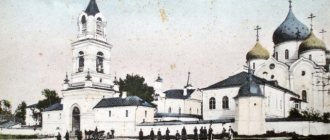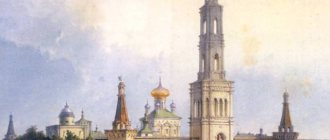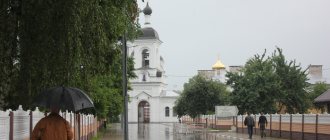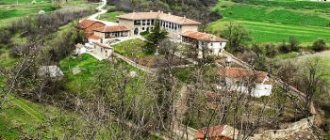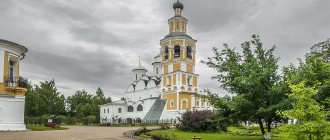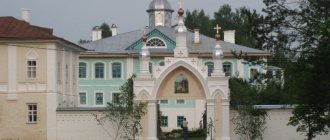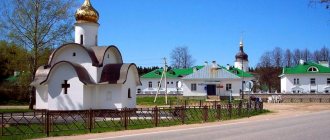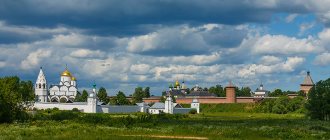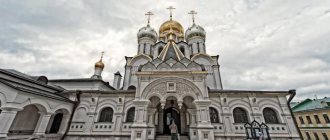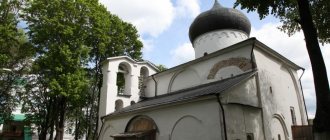Mother of God Nativity Monastery
It is located in Vladimir. The monastery was founded in 1191, by order of Grand Duke Vsevolod Yurievich. During the reign of Alexander Nevsky and more than 100 years after his death, it was one of the most influential monasteries in Rus'.
It was here that Alexander Nevsky was buried in 1263, and his relics were kept in this monastery until they were transported to St. Petersburg.
After 1917, this building housed the Cheka, and in 1930 they decided to demolish the monastery. In the same year, the cathedral and bell tower were destroyed, and pre-trial detention centers were built on this territory. Representatives of the clergy were kept in them, some of whom were sentenced to death.
All temple buildings were destroyed, with the exception of the Church of the Nativity. Since 1993, the revival of the monastery began: the preserved temple was reconstructed, and the construction of the cathedral began. Now it is a functioning monastery, which has its own shrines.
Gratitude from Ivan the Terrible
A new mention of the Spaso-Preobrazhensky Monastery dates back to the era of Ivan the Terrible. In 1552, the tsar made a third attempt to capture Kazan. Murom became the battle camp of the Grand Duke: military tents were pitched on the banks of the Oka, and rafts and plows were prepared here for the crossing. Praying for victory practically under the walls of the Spaso-Preobrazhensky Monastery, the tsar made a vow: in the event of the capture of Kazan, to build new churches in Murom.
Ivan the Terrible kept his word: soon after the campaign against Kazan, stone construction began in Murom, and soon the city was decorated with four new stone churches. At the same time, a new cathedral was built in the Spaso-Preobrazhensky Monastery. The Emperor did not forget the monastery throughout his reign, made considerable monetary contributions, donated church utensils, vestments, and books.
Pskov-Pechersky Monastery
This is one of the largest monasteries in Russia. He was located on the territory of Estonia. Because of this, it was able to survive during the difficult post-revolutionary period and never closed. But his parishioners were still discriminated against. The year of its foundation is considered to be 1473, when the cave church of the Assumption of the Mother of God was consecrated. The famous Archimandrite John (Krestyankin) once labored here.
It was about his stay within the walls of this monastery that the book “Unholy Saints” was written by Bishop Tikhon (Shevkunov), which became one of the most read among believers.
Management and caretakers
The monastery is headed by a sacred archimandrite - the ruling bishop or Patriarch, if it is a stauropegic monastery. The abbot directly controls the monastery; he can be an archimandrite, abbot, or hieromonk.
Each of the monastery residents bears a certain obedience:
- The dean is the deputy and assistant of the governor. In charge of all worship services and the fulfillment of statutory duties.
- The confessor cares for the brethren.
- Treasurer - stores and distributes funds.
- Sacristan - responsible for the splendor of the temple, service books, vestments, and utensils.
- Housekeeper - manages the economic life of the monastery.
- Cellarer - stores and prepares food.
- Hotel - receives pilgrims and guests of the monastery.
In convents, similar obediences are distributed among the sisters. It is not customary among monastics to refuse a blessing for any specific monastic work. Everything is perceived as from the hand of God, and therefore is done with joy.
Abbess
The convent is headed by the abbess, chosen from among the sisters. If there are no worthy candidates in the monastery itself, the ruling bishop appoints his own person. The abbess can be distinguished from other sisters of the monastery by her golden pectoral cross and the right to give blessings. You can address the abbess as follows: “mother abbess, mother Neonilla (or another name) or simply mother.”
Clergy
In men's monasteries, church services and services are carried out by the monastery brethren: hieromonks, hierodeacons and others. Women's monastic communities are forced to invite lay priests and deacons to ensure a continuous liturgical rhythm.
The confessor of the monastery occupies an important place. In a monastery, this does not necessarily have to be an elder, both in the sense of spiritual gifts and age. In women's monasteries, the confessor is usually appointed from among older and experienced monks.
Annunciation Monastery
This monastery has stood on the banks of the Oka River, in Nizhny Novgorod, since 1221. He had an unfortunate fate. In 1229, Prince Purgas ruined it, killing all the monks. Only 100 years later it was possible to revive it, but in 1369 the monastery was damaged by a snow collapse. Again many buildings collapsed and people died.
Metropolitan Alexy was able to revive it. He went to the Golden Horde and promised that if his visit ended well, he would rebuild it. The Metropolitan cured the Khan's wife, and he abandoned the raid. In 1370 he was able to fulfill his vow. Before the revolution, a copy of the Korsun Icon of the Mother of God was kept here, which was able to survive 3 fires. But then the monastery was closed, the list disappeared. Afterwards, a planetarium was located here. Its revival began in the 90s.
History of monasticism
“Monasticism is external and internal. You cannot ignore the external, but you cannot be satisfied with it alone either. The external alone without the internal even brings harm. External monasticism can be likened to plowing the earth. No matter how much you plow, nothing will grow if you don’t sow anything. Inner monasticism is sowing, and millet is the Jesus Prayer. Prayer illuminates the entire inner life of a monk, gives him strength in struggle, and is especially necessary when enduring sorrows and temptations...”
(Reverend Barsanuphius of Optina).
A monk (Greek μοναχός - single, single) is a member of a religious community, in accordance with a vow (oath) leading an ascetic life either within the monastic community (brotherhood), or in solitude, as a hermit.
These words of St. Hesychius fully reflect the life of a true monk. What is monasticism and why are monasteries needed in the modern world?
A monk is an Orthodox Christian who has renounced worldly life and taken vows:
– virginity (a monk cannot marry);
– obedience (a monk must obey the abbot in everything, without relying on his own will and thoughts);
– non-acquisitiveness or poverty (a monk should not have any property, everything is in common with other monks).
Monasticism originated in Egypt in the second half of the 3rd century. The first monk was Anthony the Great, he lived in the desert for more than 90 years, endured difficult trials: hunger, thirst, cold, heat, temptations and devilish attacks. People from all over the world flocked to such great ascetics and settled nearby. Monasteries began to form. In them the monks lived and worked together under the strict guidance of an experienced elder (abbot) according to strict rules.
Spaso-Preobrazhensky Solovetsky Monastery
It is located on the Solovetsky Islands, located in the White Sea. Since the 16th century, it served as a prison, which housed more than 500 people. After 1883, when the prison was closed, some church representatives who were guilty of something were still exiled to the monastery.
In 1920, the monastery was liquidated, and the Solovetsky prison appeared there, where the intelligentsia, White Army officers and clergy were imprisoned. In 1967, a museum-reserve appeared here, and in 2007 it was removed from the territory of the monastery.
Types by type of subordination
All monasteries can also be divided according to hierarchical subordination. There are three main types.
Stauropegial
They submit directly to His Holiness the Patriarch, who leads them through his viceroy. Called to serve as an example of external splendor and internal piety to other monastic monasteries.
Diocesan
The most common type of monastery, governed by a diocesan bishop. Their opening or, conversely, closing occurs on the basis of the decision of the Patriarch and the Holy Synod of the Russian Orthodox Church. The abbot(s) are appointed in the same way.
Attributed
At the most comfortable monasteries, which have a stauropegial type of subordination, assigned monastic monasteries can be created. They are significantly smaller in size and number of brethren. They are headed by the abbot, who reports to the abbot of the main monastery and the Patriarch.
Deposition of the Robe Convent
This monastery is located in Suzdal, founded in 1207. He became famous thanks to Saint Euphrosyne. In the world, she was Princess Theodulia of Chernigov, who took monastic vows in this monastery and then became its abbess. She performed many miracles during her lifetime, as well as 2 posthumous miracles, which the monk Gregory wrote about.
In 1923, the monastery was closed, its bells were sent to be melted down, and political isolation ward guards were stationed in the buildings. Only in 1999 it was returned to the church and it was revived.
V. G. Putsko. Monasteries of Ancient Rus' as a cultural phenomenon of the Middle Ages
Among the numerous Russian monasteries there were ancient ones, founded in the 11th-13th centuries. and survived eras of various national and social upheavals. There were also monasteries of Moscow Rus', which arose in the 14th-16th centuries. in different political conditions and reflecting in their structure other ideals and norms of monastic life, however, formally subordinated to the same pious intentions of personal salvation and prayerful intercession for a sinful world. However, in reality, both monasteries existed in a specific geographical and political space and were never isolated from their contemporary society, of which they remained a part under any conditions. This logically raises the question of the role of the medieval monastery in the development of national culture. A priori, one can think of it as great and exceptional, while it is difficult to reject the skeptical objections coming from supporters of the view of monasticism as a kind of abscess on the body of society. Naturally, in this state of affairs, one should appeal to specific historical facts, in most cases quite well known, although they have not been brought together to this day.
Naturally, the earliest Russian monasteries were organized on the model of the Byzantine ones, an idea of the structure of which is given by the surviving texts of their Typiks, with numerous local features, sometimes very significant.1 The history of Russian monasticism, unfortunately, does not have such an important source at its disposal.2 And therefore, the student of the cultural heritage of the Middle Ages must first of all take into account actually preserved monuments, historical material and evidence of hagiographic literature.3 Given this state of affairs, one can hardly hope for a complete coverage of phenomena. But at the same time, the noted circumstance cannot serve as a reason for refusing to address the very problem of the cultural phenomenon of the Russian Middle Ages. And some considerations, even if they are controversial, will mark a certain stage in the understanding of important and at times ambiguous phenomena that reflect the progressive development of national spiritual culture. This is the meaning of the formulated topic.
The early Kyiv monasteries were predominantly princely, and their ktitors had the opportunity to realize their ideas about the artistic appearance of the monasteries they founded.4 In the center of each of these monasteries, as a rule, stood a stone cathedral church. The nature of these structures can be judged from archaeological research data.5 The cathedral of the Vydubitsky Monastery, founded in 1070 and consecrated in 1088, has been partially preserved.6 The Cathedral of the St. Michael's Golden-Domed Monastery, built between 1108 and 1113, existed until the 1930s 7 It is famous for its mosaics made by Constantinople masters.8 The Byzantine appearance of these monastic churches, built from local materials, does not exclude the involvement of Greek architects in their creation, whose role is documented only in relation to the Assumption Cathedral of the Pechersk Monastery, founded in 1073 , completed construction in 1075.9 Although the monks of the Pechersk monastery in every possible way opposed it as created by the labors and tears of saints to the rich princely monasteries, this did not in the least prevent them from using the funds allocated by the same Kyiv princes. The real role of the latter is clearly visible in the legends of the Kiev-Pechersk Patericon against the background of the story about the miraculous calling of Constantinople architects, and later mosaicists.
The Pechersky Monastery was among the few survivors and the only one that preserved its rich historical traditions from the 11th century. One may suspect a certain bias in them, but at the same time it is difficult to ignore specific facts, partly confirmed by surviving realities. The first of these is the high educational qualification of Pechersk monks, which made it possible to nominate them to replace episcopal sees, which at the beginning of the 13th century. Vladimir Bishop Simon (1216-1226), himself a former monk of this monastery, especially noted.10
The second ability of the monks for literary work, attested to by the widely known works of St. Theodosius (c. 1036-1074)11 and Nestor,12 as well as other authors, whose works were included in the already mentioned Kiev-Pechersk Patericon. The monastery clearly had a rich library, and, according to Nestor, book writing had been practiced since the 11th century. Obviously there were manuscripts of South Slavic origin, and among them, perhaps, there was the famous Menaion of the Church with the words mainly of John Chrysostom, which later ended up in the Suprasl Monastery.13 The work of the famous icon painter Alimpiy of Pechersk, who was a direct student of the Constantinople masters, took place here.14 This is far from accidental. Nestor, in his literary work, shows an interest in art.15 In the Pechersk Monastery there were Byzantine icons,16 and church utensils made by Greek masters.17 Let this monastery be one of the few that maintained such active relations with the capital of Byzantium (it was from there that the charter was brought Studiysky Monastery), but, nevertheless, her example is indicative for determining the cultural appearance of the Kiev monastery in the most ancient period of the history of Russian monasticism.
Literary work was also carried out in other Kyiv monasteries. It is worth recalling at least the testimony of the Vydubitsky abbot Sylvester dated 111618 or the commendatory word of another abbot of the Vydubitsky monastery, Moses, included in the Hypatiev Chronicle in 1200, timed to coincide with the solemn consecration of the retaining wall built by Peter Milonego.19
In most cases, we only know about the very fact of the existence of a particular monastery from a certain time, but at the same time we are deprived of the opportunity to illuminate its life in the medieval period. The above, in particular, applies to the Yeletsky Monastery in Chernigov, the existing Assumption Cathedral of which was erected at the very beginning of the 12th century, if not in the 1090s.20 Such obviously rich monasteries could not remain aloof from the general cultural process; The combination of frescoes and stained glass in the decor of the mentioned temple itself makes one think about the place of Western elements in the real life of a Russian monastery of the Byzantine rite. In addition, the mural paintings of the Cathedral of the Nativity of the Virgin Mary in 1125 in the Novgorod monastery founded by Anthony the Roman, possibly made by Benedictine masters, also encourage.21
Rare of the early Slavic-Russian manuscripts have preserved scribes' notes, testifying to their execution in monastic book-writing workshops. All the more important are books published at the turn of the 11th-12th centuries. from the Novgorod Lazarev Monastery.2 2 Even despite their very modest graphic design, they remain valuable examples of calligraphic art. Apparently, the products of the monastery scriptoria were influenced to a certain extent by illuminated manuscripts made by masters of their craft, who were bearers of various artistic traditions, and found themselves within the walls of one or another monastery. So, in the Yuryev Monastery in Novgorod, work completed between 1119 and 1128 settled. The Gospel written by the “Ugrin”,23 and the Vygoleksensky collection of the end of the 12th century. Galician-Volhynian origin (at least the scribe was a speaker of this dialect).24 In the design of the first manuscript there are Carolingian and Romanesque decorative motifs, in the second, not yet adapted Byzantine ones, which also became widespread in the illumination of Bulgarian manuscripts. Rostov Bishop Kirill, ordained in 1216 from the monks of the Dmitrievsky Monastery in Suzdal, is known to have been a collector and owner of remarkable manuscripts, which, obviously, only partially could have followed him in 1229 to the place of his tonsure.25 From the life of St. Euphrosyne of Polotsk can be seen that book writing in the 12th century. They also practiced in nunneries.
No matter how meager and fragmentary the information given is, behind it one can still discern a fairly clearly organized cultural life of the medieval Russian monastery, designed primarily to serve the requirements of the liturgical structure inherited from Byzantium. Items of Byzantine church utensils, of course, were very desirable, but they practically could not be numerous and have widespread distribution. Therefore, they also willingly used products of Western origin,26 and, of course, items made by local craftsmen clearly predominated. In order to provide even the monasteries known by name with everything they needed, a larger number of books, icons, vestments, and various utensils, from liturgical vessels to choresses and censers, were required. Jewelry, as a rule, was the first to disappear, and therefore only a few examples are known.
The situation is somewhat better with the characteristics of the cultural appearance of Russian monasteries in the 14th and 16th centuries. The monastic architectural ensembles themselves, with their distinctive layouts, church and outbuildings, have been better preserved.27 In some cases, the interior design of monastic churches has survived, and here the iconostasis of the Trinity Cathedral of the Trinity-Sergius Lavra should be especially noted. Comparatively until recently, there were only partially disturbed libraries and sacristies, of which now the most satisfactorily preserved is the Trinity Lavra of St. Sergius, well known thanks to partly its published treasures.28 This sacristy, for all its exclusivity, can still serve as a mirror of both the development of the church art of Rus' XIV-XVI centuries. in general, and the role of monasteries in this process, in particular. Of course, not every one of the rich Russian monasteries of this period could collect at least part of such treasures within its walls. However, if we move from general admiration to a sober analysis of the materials accumulated over centuries, it turns out that they are far from equal in their artistic level. Masterpieces, naturally, are too few in number compared to the prevailing objects of artistic craft. It would seem that in the Trinity-Sergius Monastery the latter, through the efforts of local craftsmen, retained all the signs of elitism. But here, too, some disappointment awaits: Ambrose and the few carvers close to him were rather the exception. In the middle of the fifteenth century. In the monastery there turned out to be a masterly carved wooden pectoral folding cross, clearly made by one of the brilliant Constantinople masters, which was stored here back in 1928. Its carving soon began to be repeated in a simplified version in products made of wood and bone by local artisans and by the beginning of the 16th century. brought it to the point of schematism. Of course, it does not follow from this that plastic art in the monastery followed the path of degradation, but such examples were still taken into account.
In any case, medieval Russian monasteries, in terms of artistic phenomenon, retain the significance of historically established artistic treasuries, even regardless of the quantitative composition of the accumulated works. Well-known inventories and loose-leaf books give a clear idea of it.29 The things noted in them cannot always be discovered, and yet the need to prepare a publication of these treasures, which give an idea of the development of Russian sacred art of the Middle Ages as a whole, is long overdue. Along the way, it turns out that Byzantine works, it seems, mostly ended up within Rus' after 1453, when Byzantium ceased to exist, and the impoverished Greeks began to increasingly turn to their rich northern coreligionists for material help. At least, the surviving cameos, with a few exceptions, are in Russian jewelry settings of the 16th and 17th centuries, and this should not be ignored.
To date, bookmaking in Moscow and Moscow region monasteries of the 14th and early 15th centuries has been thoroughly studied. 30 And its samples, accordingly, give an idea of the calligraphic art of that time. There are also experiments in studying the handwritten products of individual scribes, such as Rev. Nil Sorsky is one of the strictest Russian ascetics of the 15th century.31 In the Christian world he is known thanks to the Rules of skete life that he compiled.32 The libraries of northern Russian monasteries were also the subject of study.33 However, the accumulated observations are clearly not enough for a general comprehensive description, and therefore the problem of a cultural phenomenon ancient Russian monasteries requires further development, involving private research. In the meantime, of necessity, we have to judge general phenomena using specific examples.
Nothing was said here about the internal structure of the monasteries, about the experiments in introducing communal regulations into them, about the large and varied economic, and at times, missionary activities. But this does not mean at all that the past of such large monasteries as Kirillo-Belozersky remains unknown to us.34 That the experiments in analyzing the internal life of the ancient Pechersky Monastery are not taken into account.35 That, finally, many important and interesting monuments of artistic culture are left without attention, including including those that have long been covered by special research. Our goal was to present a few historical facts that allow us to look at monasteries as centers of cultural life in medieval Rus'.
The social and cultural significance of these monasteries clearly varied. In some of them there were rich and carefully stocked libraries, book-writing workshops, icon painters and various artisans, whose products were carried far and wide by pilgrims. In others, poor and provincial, they had the most necessary things, and they had no idea about any masterpieces of art here. But culture lives and develops in its most varied manifestations, and even self-reading books, paying attention to singing and the daily poetic texts of prayers at daily services, was in essence an introduction to the treasures of Christian spirituality. Sometimes ordinary and inconspicuous. The general way of life, which was preserved in the living monastic tradition and in the life of the Old Believer, shows that a person, even seemingly not inclined to intellectual work, received the amount of knowledge that non-church people assimilate with great effort. Illiterate peasants who found themselves among the monastic brethren sometimes became well erudite in Scripture and patristic literature.
Universities arose quite early in Western Europe, and among Catholic monasticism a penchant for scientific pursuits was cultivated. Foreigners were sincerely perplexed why the Greeks, after the fall of Byzantium, founded universities in Italy, and not in Moscow, their co-religionist. But Moscow, with its idea of the Third Rome, turned out to be more in need of Sophia Paleologus, and a little later, the most learned Maxim the Greek appeared, and was doomed to humiliation and many years of imprisonment. And in the 16th century, as before, the function of the university was carried out by monasteries. It was from there that many writers and prominent church figures came out, not only well-read, but also with practical experience in teaching and running a complex economy. This, perhaps, most clearly reflected the cultural phenomenon of the medieval Russian monastery, the life of which was largely hidden from prying eyes. It seems that this circumstance still makes it difficult to broadly characterize the cultural activities of even those monasteries, the results of which are obvious.
1 Dmitrievsky A. Description of liturgical manuscripts stored in libraries of the Orthodox East. Kyiv, 1895. T. 1: Typika. Part 1.
2 See: Kazansky P. History of Orthodox Russian monasticism from the founding of the Pechersk Monastery by St. Anthony to the founding of the Lavra of the Holy Trinity by St. Sergius. M., 1855.
3 Putsko V. Liturgical and everyday life of a medieval Russian monastery // La vie quotidienne des moines et chanoines reguliers au Moyen Age et Temps modernes. Actes du Premier Colloque International du LARHCOR, Wroclaw - Ksiaz, 30 November - 4 December 1994. Wrozlaw, 1995. pp. 721 - 727.
4 Slyusarev V. Churches and monasteries built in Kyiv by princes, starting with the sons of Yaroslav until the end of the Kyiv Grand Duchy // Proceedings of the Kyiv Theological Academy. 12 892. T. 33. Part 1. pp. 104 - 154.
5 Summarized in the book: Rappoport P. A. Russian architecture of the X - XIII centuries. Catalog of monuments. L., 1982. (SAI. Issue E 1 - 47).
6 Ibid. P.26−27(No35).
7 Ibid. P.16−17(No18).
8 Lazarev V. N. Mikhailovsky mosaics. M., 1966.
9 Rappoport P. A. Russian architecture of the X - XIII centuries. pp. 23 - 25 (No. 33). For more details, see: Kholostenko M.V. Assumption Cathedral of the Pechersk Monastery // Ancient Kiev. Kiev, 1975. P. 107 - 170.
10 For more details, see: Voronin N.N. On the question of the beginning of the Rostov-Suzdal chronicle // Archaeographic Yearbook for 1964. M., 1965. S. 21 - 24.
11 Chagovets V. A. Life and works of St. Theodosius. Kyiv, 1901; Eremin I.P. Literary heritage of Theodosius of Pechersk // Proceedings of the Department. other Russian lit. 1947. T. V. P. 159 - 184.
12 Boguslavsky S. L. On the question of the nature and scope of the literary activity of the teacher. Nestor // Izv. Dept. rus. language and words. AN. 1914. T. XIX. Book 1. P. 131 - 186; Book 3. pp. 153 – 191.
13 Suprasalski or Retkov collection. Sofia, 1982 - 1983. T. 1 - 2.
14 Putsko N. Kiev artist of the 11th century Alimpiy Pechersky. (According to the legend of Polycarp and data from archaeological research) // Wiener slavistisches Jahrbuch. 1979. Bd. 25. pp. 63 – 88.
15 Putsko V. Some episodes from the Life of St. Theodosius of Pechersk // Old Bulgarian literature. 1990. Book. 23 - 24. pp. 57 - 62.
16 Karabinov I. A. “Regional icon” of the ancient Kiev Pechersk monastery // Izv. State Academy of Material Culture. L., 1927. T. 5. P. 102 - 113; Putsko V. Pechersk ktitor portrait // Zograf. Beograd, 1982. Book. 13. P. 42 - 48; aka. Pechersk icon of the Dormition of the Mother of God: legend and history // Roddovid. 1994. Part 9. pp. 65 - 74.
17 Putsko V. G. Cross of Mark Peschernik // SA. 1987. No. 1. P. 217 - 229.
18 Poppe A.V. About the recording of Abbot Sylvester // Culture of medieval Rus'. L., 1974. S. 51 - 52.
19 Borovsky Y. E. “Eulogous word” of Moses, hegumen of the Vidubitsky monastery // Literary decline of Kievan Rus and Ukrainian literature XVI - XVIII centuries. Kiev, 1981. pp. 54 -58.
20 Rappoport P. A. Russian architecture X - XIII centuries. P.45−46 (No. 63).
21 Putsko V. Novgorod frescoes of the 12th - 13th centuries // Wandmalerei des Hochfeudalismus im europaischbyzantinischen Spannungsfeld (12. und 13. Jahrhundert). Halle, 1983. pp. 192 - 195.
22 Yanin V.L. Novgorod scriptorium at the turn of the 11th - 12th centuries. Lazarev Monastery // Archaeographic Yearbook for 1981. M., 1982. S. 52 - 63.
23 Putsko V. Artistic decoration of the St. George’s Gospel // Ars Hungarica. 1979. No. 1. P. 7 - 21. Ill. 112.
24 Vygolensky collection. M., 1977. See fig. 1 - 29.
25 Wed: Vzdornov G.I. The art of books in Ancient Rus'. Handwritten book of North-Eastern Rus' of the 12th - early 15th centuries. M., 1980. P. 21.
26 For more details, see: Darkevich V.P. Works of Western artistic craft in Eastern Europe (X - XIV centuries). M., 1966. (SAI. Issue E 1 - 57).
27 For some of them, see: Architectural Monuments of the Moscow Region. M., 1975. T. 1 - 2; Vygolov V.P. Architecture of Moscow Rus' of the 15th century. M., 1988; Podyapolsky S.S. On the characteristics of Kirill’s architecture of the 15th-16th centuries // SA. 1966. No. 2. P.75−95; aka. Architectural monuments of the Spaso-Kamenny Monastery (XV - XVI centuries) // Old Russian art. Artistic culture of Moscow and the adjacent principalities of the 14th - 16th centuries. M., 1970. S. 437 - 457; Baldin V.I. Architectural ensemble of the Trinity-Sergius Lavra. M., 1976.
28 See: Nikolaeva T.V. Works of small sculpture from the 13th to 17th centuries in the collection of the Zagorsk Museum. Catalog. Zagorsk, 1960; she is the same. Old Russian painting of the Zagorsk Museum. M., 1977; Olsufiev Yu. A. Inventory of ancient church silver b. Trinity-Sergius Lavra. Sergiev, 1926.
29 See for example: List of the acquired images of all ranks of weight gain selected in 722 in the Pokrovsky nunnery // Proceedings of the Vladimir Scientific Archival Commission. Vladimir, 1908. Book. X; Inset book of the Trinity-Sergius Monastery. M., 1987; Inset book of the Serpukhov Vysotsky Monastery. M., 1993; Inventory of Savvin the Watchtower Monastery of the 17th century. M., 1994.
30 Vzdornov G.I. Book writing and artistic design of manuscripts in Moscow and Moscow region monasteries until the end of the first third of the 15th century. // Interaction of literature and fine arts of Ancient Rus'. M.; L., 1966 (TODRL. T. XXII). pp. 119 – 143.
31 Prokhorov G. M. Autographs of Nil Sorsky // Cultural Monuments. New discoveries. 1974. M., 1975. S. 37 - 54.
32 Our venerable and God-bearing father Nil of Sorsky and his Charter on monastic life... M., 1991.
33 Kukushkina M.V. Monastic libraries of the Russian North. Essays on the history of book culture of the 16th - 17th centuries. L., 1977. See also: Book centers of Ancient Rus'. Joseph-Volokolamsk Monastery as a center of book learning. L., 1991.
34 Nikolsky N.K. Kirillo-Belozersky Monastery. St. Petersburg, 1897, 1910. T. 1 - 2.
35 See: Priselkov M.D. Essays on the church-political history of Kievan Rus X - XII centuries. St. Petersburg, 1913.
← Back | Forward →
Kirillo-Belozersky Monastery
Its other name is the Kirillov Monastery. It is located near Lake Siverskoye in Kirillov. The monastery flourished in the 15th-17th centuries, when it was the largest and richest in Russia. Its charter was particularly strict. It was one of the Russian book centers.
It is believed that here the royal couple begged for an heir, who later became Ivan the Terrible. After the revolution, the monastery was destroyed, its abbot was shot. Everything was taken away, and the monastery library was also taken away. It could have been destroyed and demolished if a museum-reserve had not opened here in 1924. Until now, believers are trying to revive monastic life within its walls.
Monasticism in Russia
In Rus', monasticism gained great popularity and people's love. The first monastery was founded in 1051 by Anthony of the Pechersk in Kyiv and was named the Kiev-Pechersk Lavra. At this time, other monasteries were built in Kyiv: Dimitrievsky, Spassky Berestovsky, Klovsky Vlakhernsky. Monasteries began to appear on the map of the country more and more often. Each ruler sought to found a monastery in his capital city.
The monasteries of Russia became not only places of solitary prayer for monks, but also large educational centers. Christians from all over the country flocked to Orthodox monasteries for advice from experienced elders, asking for prayer and material help. Orthodox shrines have had to endure many trials over their long existence, but even today Russian monasteries are being revived or built in new places.
Operating monasteries in Russia are favorite places of pilgrimage for Orthodox Christians. Here you can retire from the bustle of the world and gain spiritual strength, get advice from experienced priests and work for the Glory of God.
Holy Trinity Sergius Lavra (Sergiev Posad, Moscow region)
Vvedenskaya Optina Pustyn
This one of the oldest monasteries is located near the city of Kozelsk. According to legend, it was founded by a repentant robber named Opta.
In 1821, a monastery appeared here, and hermits settled in it. People from all over Russia reached out to them, trying to get answers to their questions and healing. After the death of his son F.M. Dostoevsky stayed in the monastery for 3 days.
The monastery became famous for the Optina elders, who became the comforters of the people. After the revolution, Optina Pustyn was closed; it housed a rest home, a concentration camp, and a hospital. In 1987 it was returned to the church.
Monks' routine
The central core of monastic life is church worship, which, according to St. Basil the Great, there is “...intense, constant and undistracted attention to the One Whom you serve.”
Monastic life also includes:
- Performing various obediences - monastic works.
- Social service: caring for the poor, maintaining charity houses, etc.
- Educational initiative: publication of spiritual literature, implementation of various missionary projects.
- Other activities.
The time a monk spends outside the church is spent in unceasing internal prayer. This is what he lives and breathes; the commandment “...pray without ceasing...” is taken and followed literally by him. Monks are Christians who, as far as possible, leave earthly affairs for a fuller and deeper practice of prayer, in order to unite with God through it.
St. George's Monastery
Near the Volkhov River, on the outskirts of Veliky Novgorod, the Yuriev Monastery is located. It was founded in 1030, once considered the spiritual center of the entire Novgorod land. After the October Revolution, all valuables were removed from the monastery, and after 1932 it became a home for the disabled. Later people lived here, a post office and other institutions were located. Only in the 90s did its revival begin.
Valaam Spaso-Preobrazhensky Monastery
It is located on an island in Lake Ladoga, surrounded on all sides by water. It is considered one of the most beautiful monasteries. It is called Northern Athos. It was attacked and ravaged more than once, but the monks never took up arms or defended themselves, preferring to die.
The monastery flourished in the 19th century. After the revolution, he remained on the territory of Finland, thanks to which he was able to survive, but was subject to discrimination by the Finnish authorities. Until 1940, Valaam belonged to Finland, but then again went to Russia after the Russian-Finnish War. Now pilgrims flock to it, attracted not only by the history of the monastery, but also by the beautiful landscapes.
Forms of monastic life
Monasticism in the form in which it exists now did not take shape overnight. It went through different forms, the most acceptable in one period or another.
Hermits
This is a special type of monastic work, which is undertaken only by those who have passed the test in communal monasteries, having received the necessary spiritual practice and experience.
In order to carry out special ascetic deeds and prayer, such a monk can receive the blessing of the governor for a solitary life. The monk remains to live in obedience to the abbot, but is freed from monastic labors and somewhat withdraws from all the brethren. Modern hermitage is most often a seclusion within an ordinary communal monastery.
Hermitage life
In a small monastic settlement, remote from the main monastery, life, as a rule, follows a more strict rule. There are more opportunities for solitude and performing special feats of abstinence. The small number of brethren and the absence of pilgrims create all the conditions for inner prayer and contemplation.
Dormitory
The most common form of monastic life. Here conditions are formed that are most conducive to spiritual success.
First of all this:
- freedom from material worries;
- renunciation of one's own will;
- living together with neighbors, due to which many “sharp” corners of character are cut off.
A spirit of unity and evangelical love is formed between brothers. At the same time, there is unquestioning obedience to the abbot(s). In addition, there is common worship, meals, residence and property, as well as lifelong care for all members of the community.

